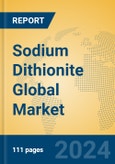Market Size and Growth Forecast
The global Sodium Dithionite market was valued at USD 1.3-2.2 billion in 2024, with an estimated CAGR of 4.0%-6.0% from 2025 to 2030, driven by demand in textiles and pulp and paper applications.Regional Analysis
- North America is projected to grow at a CAGR of 3.8%-5.8%, with the U.S. leading due to its pulp and paper and water treatment sectors, focusing on eco-friendly sodium dithionite solutions.
- Europe is expected to achieve a CAGR of 3.5%-5.5%, with Germany driving demand through its emphasis on sustainable textile and polymer applications.
- Asia Pacific is anticipated to record the highest growth at 4.5%-6.5%, led by China and India, where textile and paper industries fuel demand, with trends toward large-scale, sustainable production.
- Rest of the World, particularly Brazil, is expected to grow at 3.3%-5.3%, with trends toward mining and water treatment applications.
Application Analysis
- Chemical intermediates are estimated to grow at a CAGR of 4.0%-6.0%, driven by chemical synthesis needs, with trends toward eco-friendly formulations.
- Textile applications are projected to grow at 4.5%-6.5%, valued for bleaching and dyeing, with innovations in sustainable processes.
- Mining applications are expected to grow at 3.8%-5.8%, used in mineral processing, with advancements in efficiency.
- Pulp and paper applications are projected to grow at 4.3%-6.3%, critical for bleaching, with trends toward eco-friendly solutions.
- Polymer production and processing are expected to grow at 3.5%-5.5%, used in high-performance materials, with advancements in processing efficiency.
- Personal care and water treatment applications are projected to grow at 3.8%-5.8%, with trends toward sustainable, high-purity formulations.
- Other applications, including food processing, are expected to grow at 3.3%-5.3%, with trends toward niche chemical uses.
Key Market Players
BASF, headquartered in Ludwigshafen, Germany, produces sodium dithionite for textiles, known for its high-quality chemical solutions.Nouryon, based in Amsterdam, Netherlands, offers sodium dithionite for pulp and paper, emphasizing sustainable production methods.
Chemtrade Logistics, headquartered in Toronto, Canada, provides sodium dithionite for mining, focusing on efficient processing solutions.
Bruggemann, based in Heilbronn, Germany, produces sodium dithionite for chemical intermediates, known for its innovative formulations.
Silox India, headquartered in Mumbai, India, offers sodium dithionite for textiles, emphasizing cost-competitive solutions.
Nagao & Co., based in Kobe, Japan, provides sodium dithionite for pulp and paper, focusing on precision manufacturing.
Guangdi Maoming Chemical, headquartered in Maoming, China, produces sodium dithionite for textiles, known for its large-scale production capacity.
TCP Limited, based in Chennai, India, offers sodium dithionite for mining, emphasizing industrial applications.
MGC, headquartered in Tokyo, Japan, produces sodium dithionite for polymer production, focusing on advanced materials.
Hansol Chemical, based in Seoul, South Korea, provides sodium dithionite for pulp and paper, known for its eco-friendly solutions.
Cathay Chemical Works, headquartered in Taipei, Taiwan, offers sodium dithionite for textiles, emphasizing scalable production.
Guangdong Zhongcheng, based in Guangdong, China, produces sodium dithionite for water treatment, focusing on environmental compliance.
Zhejiang Runtu, headquartered in Hangzhou, China, provides sodium dithionite for textiles, known for its robust production capacity.
Hubei Yihua, based in Yichang, China, produces sodium dithionite for pulp and paper, emphasizing large-scale manufacturing.
Shandong Jinhe, headquartered in Jinan, China, offers sodium dithionite for mining, focusing on efficient solutions.
Kutch Chemical Industries, based in Kutch, India, produces sodium dithionite for textiles, known for its regional expertise.
Jiang Xi Hongan Chemical, headquartered in Jiangxi, China, provides sodium dithionite for textiles, emphasizing cost-effective production.
Porter’s Five Forces Analysis
- The threat of new entrants is low; high capital costs and stringent environmental regulations create significant barriers to entry.
- The threat of substitutes is moderate; alternative reducing agents like sodium bisulfite compete in certain applications, but sodium dithionite’s efficiency maintains its advantage.
- Buyer power is high; large textile and paper industries negotiate pricing aggressively, increasing competitive pressure.
- Supplier power is low; raw materials for sodium dithionite production are widely available, reducing supplier influence.
- Competitive rivalry is high; players differentiate through eco-friendly production, cost efficiency, and application-specific innovations.
Market Opportunities and Challenges
Opportunities
- Growing textile and pulp and paper industries, particularly in Asia Pacific, drive demand for sodium dithionite.
- Increasing adoption of eco-friendly water treatment solutions enhances market potential.
- Emerging markets in Asia Pacific offer growth opportunities due to industrial expansion and large-scale production.
Challenges
- Stringent environmental regulations in China and globally increase production compliance costs.
- Fluctuating raw material prices impact profitability and cost structures.
- Market consolidation in China limits opportunities for new entrants and smaller players.
Growth Trend Analysis
The Sodium Dithionite market is experiencing steady growth, driven by strong demand in textiles and pulp and paper industries. Prior to 2013, the global sodium dithionite capacity was approximately 350,000 tons per year, with six producers in China dominating the market. Between 1998 and 2007, the market saw high profitability, with prices reaching up to 11,000 yuan per ton and profit margins exceeding 150% for early producers. From 2013, new capacity additions included Jiang Xi Hongan Chemical (50,000 tons), Guangdi Maoming Chemical (140,000 tons), Shandong Jinhe, and others, adding 200,000 tons. However, from 2014, environmental regulations led to the closure of Guangdong Zhongcheng, Hunan Zhongcheng, Liuzhou Zhongcheng, and Shandong Jinhe, reducing capacity by 300,000 tons. Currently, the global capacity is around 380,000 tons, with demand at approximately 400,000 tons, indicating a balanced market with steady growth. Hubei Yihua maintains a capacity of 100,000 tons, focusing on pulp and paper applications. These developments align with a projected CAGR of 4.0%-6.0% through 2030, reflecting the industry’s focus on sustainability and efficiency in response to environmental pressures.This product will be delivered within 1-3 business days.
Table of Contents
Companies Mentioned
- BASF
- Nouryon
- Chemtrade Logistics
- Bruggemann
- Silox India
- Nagao & Co. Ltd.
- Guangdi Maoming Chemical
- TCP Limited
- MGC
- Hansol Chemical
- Cathay Chemical Works
- Guangdong Zhongcheng
- Zhejiang Runtu
- Hubei Yihua
- Shandong Jinhe
- Kutch Chemical Industries Ltd
- Jiang Xi Hongan Chemical








